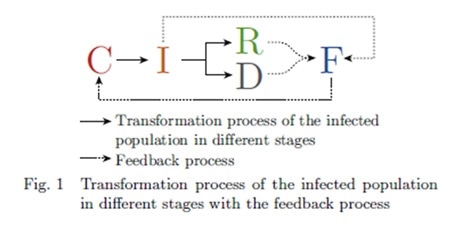The rapid spread of the COVID-19 pandemic led Chinese researchers to model the course of the epidemic early in the year. Their study was published in the Journal of Shanghai Jiao Tong University.
The Chinese government swung into action to contain viral spread once the epidemic was made public. The measures taken included traffic restrictions, the extension of public holidays, and lockdowns in Wuhan and other cities in the affected province of Hubei.

Wuhan, Hubei / China - March,30,2020 : Wuhan Guanggu shopping city after lockdown in Wuhan. Image Credit: Mark Brandon / Shutterstock
The problem is that such measures must be applied with Draconian severity to have an adequate effect. These measures cause significant social problems as well as adverse economic impacts. To better understand the benefit of these measures, including the advisability of extending them into the future, it is necessary to analyze and quantify their effects.
What models were used?
The researchers mention several types of models that could have been used, such as the cabin model and the cellular automation types. With their disadvantages, the team decided to use a reality-based transmission analysis.
The model is called the incubated, the infected, the recovered, the death, and an infection function (i.e., CIRD-F model), and it predicts the spread of the epidemic. All the previous models had their limitations, prompting the creation of the CIRD-F model to increase prediction accuracy.
This model comprises four groups, such as the incubated, the infected, the recovered, and the dead. It considers the public knowledge of the infected population and viral transmissibility. The researchers used this data to formulate four differential equations and one functional equation.
The aim is to use cumulative infection data to evaluate the quantum of public vigilance and viral capacity to spread. This will go on to the prediction of future infections, incubations, recoveries, and deaths.
A second model used by the researchers is the capital asset pricing model with a dummy variable, which is called the CAPM-DV model. The dummy variable is assigned a value first to represent the start time of the epidemic. Then the day of publication of the official policies on the industry representing the role played by the infection. This allows a more nuanced approach to the effect of the policies on a range of industries.
How was the modeling done?
The experiments began with fitting the CIRD-H model to the most affected cities. The researchers first applied the model to Wuhan in Hubei, then Hubei, and then China separately. The situations in and outside Hubei were significantly different in severity. The curves predicting the epidemic were drawn by combining the curves of each.
Secondly, they analyzed and tried to predict the tendency of the epidemic if official closure policies were in place and if not. The underlying assumption is that without such a move in Wuhan, the whole country would have suffered a similar fate as Wuhan. For this reason, the tendency in China is predicted by the model for Hubei.
This shows that such policies would avoid about 68% of possible infections. The researchers used a predictive cabin model built on propagation dynamics, which is derived from the model with negative feedback.
Secondly, the CAPM-D model is used to predict the extent of the economic downturn in sectors such as healthcare, construction, entertainment, transportation, and tourism. The CAPM-D model allows the official policy to be examined from a fresh perspective.
The CIRD-F model?
As mentioned above, the CIRD-F model comprises four differential equations to represent how the infected population passes through different stages – incubation period, infection period, recovery period, and death state due to COVID-19.

The assumptions that help to translate these transformation processes in clear and simple terms to build this model include the following:
- Adequate hospital beds and quarantine facilities to ensure immediate quarantine of each patient, without a further spread of infection once hospitalized
- Reinfection is not a possibility
- Cure rates and death rates are taken as stable throughout the study period
The various stages of the infection are:
- Incubation period – people are asymptomatic but can infect other healthy people. This is taken as three days.
- Infection period – symptomatic and enter immediate quarantine, no more extended sources of infection as a result.
- Recovery period – those who survive the infection period, not infective, thought to be immune
- Death state – those who die during the infection period, not infective.
The researchers assume that as the number of infected individuals goes up over time, the public awareness of the threat increases, and the number of new infections, therefore, goes down. This is a negative feedback effect. Since the transmissibility of the virus remains unchanged, measures to prevent transmission are the means to bring the number of people in the incubation period to zero.
The predictions
The researchers estimated that this would occur on about March 17, 2020, in Hubei, and around March 2, 2020, in the rest of the country. The epidemic tendency is calculated separately in the two regions because of the many variations between them concerning lockdown measures, traffic control, and medical services saturation.
According to their modeling, the epidemic in China was to peak on around February 17, 2020, at about 72,000 people. They predicted that about 78,000 people would be infected at that time, the actual was just over 81,000. The number of daily infections would decline rapidly to zero over the ten days from February 23, 2020. As of 17th April, approximately 20 days later than predicted, reported new daily cases have fallen to near zero.
With respect to the effect of official policies, they summarize: “The predicted number of cumulative infections greatly exceeds the actual number of cumulative infections, which means the control of the government is effective.” If early strict control had been implemented in Hubei, the number of cases would be 68% less.
Economic impact
With respect to industries, the model predicts a positive impact on the healthcare industry by 0.373%; but negative impacts on the transportation, construction, and tourism industries by 0.0348%, 0.245%, and 0.058%, respectively.
However, as a result of the official policies, the healthcare industry was affected negatively by 0.064%, despite the positive stimulus of the epidemic. The transportation, construction, and tourism industries all suffered 0.260%, 0.345%, and 0.220% additional losses after the official policies were announced.
The negative effect on the healthcare industry after the announcement of the policies is perhaps due to the subsidence of public emotions, leading to the cessation of panic buying of drugs. Transportation impacts appear to recover after the policy announcement relative to the original losses, perhaps due to the increased movement of personnel and materials to handle the health crisis.
What does the model show?
The importance of the model is its ability to offer a universal method to calculate the impact on the industries – if the stock indices of several companies within a given industry are available, the impact on the industry can be obtained.
The model thus shows that the epidemic in China will terminate towards the middle of March 2020. Official guidelines and measures will be the deciding factor in containing the number of infections. In China, the number of cases would be higher by about 50,000 in the absence of timely official interventions. Finally, if Hubei were to adopt the same tight measures as other regions in China, there would be an approximately 70% reduction in the number of infections, confirming the need for early prevention and control of the epidemic by appropriate policies.
The economic impact modeling tool, CAPM-DV, shows positive and negative impacts of the epidemic and official interventions on various industrial sectors, namely, healthcare, transportation, construction, and tourism. The epidemic, as such, has a positive impact on the healthcare industry, while the impact of the official policies is relatively less negative concerning the transportation industries.
As of April 22, 2020, China has 83,853 confirmed cases and 4,636 reported deaths.
Journal reference:
Lingyun, Z., Kaiwei, W., Hanzhi, L., Yuanning, G., and Xiaofeng, G. (2020). CIRD-F: Spread and Influence of COVID-19 in China. Journal of Shanghai Jiao Tong University. (Scientific), 25(2): 147-156. https://doi.org/10.1007/s12204-020-2168-1